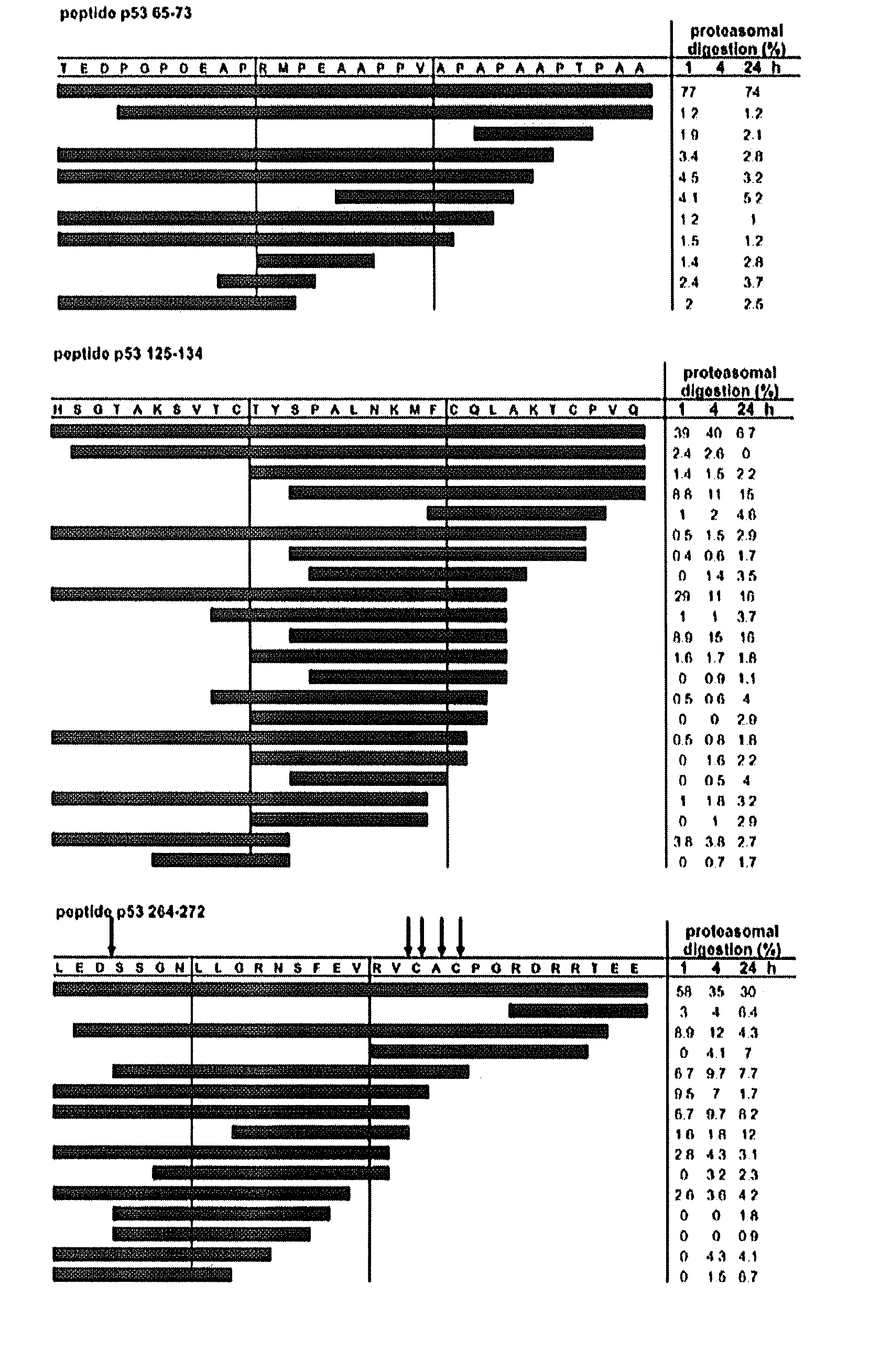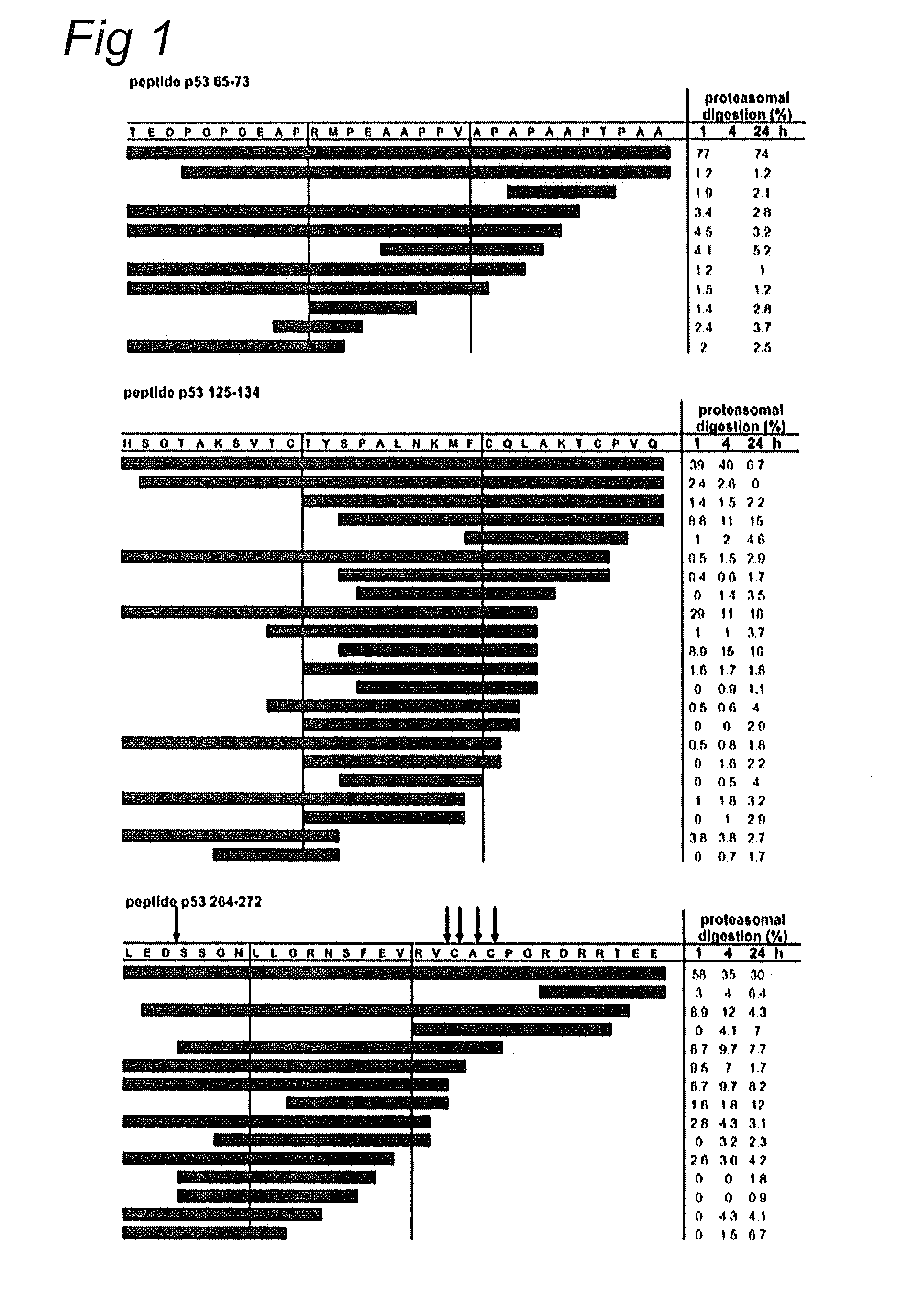P53 peptide vaccine
a peptide and vaccine technology, applied in the field of medicine and immunology, can solve the problems that peptides derived from ubiquitously expressed self-antigens, such as p53, will not be able to trigger a strong and effective immune response in vivo
- Summary
- Abstract
- Description
- Claims
- Application Information
AI Technical Summary
Benefits of technology
Problems solved by technology
Method used
Image
Examples
example 1
Relation Between HLA Binding, Proteasomal Digestion and Tolerance
[0094]A modest surface expression of certain class I MHC-restricted peptides can be achieved by several, not mutually exclusive, mechanisms: 1) to low expression or to low turn-over of proteins in the cell resulting in the generation of insufficient numbers of epitopes that allow recognition by CTL (Vierboom M P et al), 2) peptides with only a weak binding capacity for MHC may lose the competition with peptides with better MHC-binding properties and as such are scarcely expressed at the cell surface, and 3) proteosomal generation of CTL epitopes may be insufficient to generate effective numbers of MHC-peptide complexes.
[0095]As part of normal cell regulation, p53 protein is targeted for proteasome-mediated degradation and shortage of protein entering the proteasome is therefore not likely to play an important role in the escape of negative selection. We have, therefore, analyzed the binding capacity of p53 derived pept...
example 2
Vaccination Study with p53 Peptides in Ovarian Cancer Patients-Immunological Results in 7 Vaccinated Patients
Objectives of the Trial
2.1 General Objectives
[0103]Primary objective:[0104]To evaluate the safety and tolerability of a p53 specific “long peptide” vaccine in combination with a defined adjuvant with known mode of action (Montanide ISA) (phase I part of the study)[0105]To evaluate the immunogenicity of a p53 specific “long peptide” vaccine in combination with a defined adjuvant with known mode of action (Montanide ISA) (phase II part of the study)
2.2 End-Points
[0106]Primary endpoint of the phase I study is safety and tolerability
[0107]Primary endpoint of the phase II study is immunogenicity (p53 specific T cell responses)
2.3. Trial Design
[0108]A phase I / II vaccination study was performed in patients with ovarian cancer, using 10 overlapping p53 peptides in combination with an adjuvant with a sustained dendritic cell activating ability (Montanide-ISA-51). The flow chart phase ...
example 3
Vaccination Study with p53 Peptides in Colorectal Cancer Patients-Immunological Results in 2 Vaccinated Patients
[0165]The principle of the study is similar as in example 2 (see also FIG. 3). The differences being that in this study, patients only received two vaccinations (instead of four).
[0166]The p53-specific proliferative capacity (FIGS. 5A and C) and cytokine production (FIGS. 5B and D) of 2 male patients with colorectal cancer is shown before and after vaccination with p53-long peptide vaccine. Patients were vaccinated twice with overlapping p53 peptides covering the amino acid sequence 70-248 (indicated by the pools of 2 peptide: V70-115, V102-155, V142-203, V190-248). Patients PBMC were also tested against the N-terminal region of p53 (aa 1-78) and C-terminal region of p53 (aa 241-393). Note that in both cases, vaccination results in the activation of T-cell reactivity against the C-terminal region (outside the vaccine) too, indicative for epitope-spreading of the immune res...
PUM
| Property | Measurement | Unit |
|---|---|---|
| diameter | aaaaa | aaaaa |
| flow rate | aaaaa | aaaaa |
| concentration | aaaaa | aaaaa |
Abstract
Description
Claims
Application Information
 Login to View More
Login to View More - R&D
- Intellectual Property
- Life Sciences
- Materials
- Tech Scout
- Unparalleled Data Quality
- Higher Quality Content
- 60% Fewer Hallucinations
Browse by: Latest US Patents, China's latest patents, Technical Efficacy Thesaurus, Application Domain, Technology Topic, Popular Technical Reports.
© 2025 PatSnap. All rights reserved.Legal|Privacy policy|Modern Slavery Act Transparency Statement|Sitemap|About US| Contact US: help@patsnap.com



